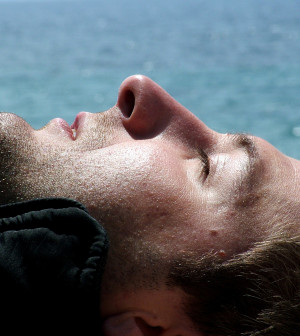- Navigating Your Midlife Crisis: Embracing New Possibilities
- City Raccoons Showing Signs of Domestication
- Mapping the Exposome: Science Broadens Focus to Environmental Disease Triggers
- One Week Less on Social Media Linked to Better Mental Health
- Your Brain Changes in Stages as You Age, Study Finds
- Some Suicide Victims Show No Typical Warning Signs, Study Finds
- ByHeart Formula Faces Lawsuits After Babies Sickened With Botulism
- Switch to Vegan Diet Could Cut Your Greenhouse Gas Emissions in Half
- Regular Bedtime Does Wonders for Blood Pressure
- Dining Alone Could Mean Worse Nutrition for Seniors
Suicides Decline With Prevention Measures at Known ‘Hotspots’: Study


Preventive measures at “suicide hotspots” such as high bridges and cliffs might greatly reduce the number of suicides at these locations, a new review suggests.
Researchers analyzed data from 18 studies to determine the effects of three methods of suicide prevention in use at known suicide hotspots around the world.
The intervention methods include signs that encourage people to seek help and provide crisis telephone numbers (help-seeking), increased video surveillance and suicide patrols (third-party help), and measures such as installing safety nets and barriers to block the means of suicide (access restriction).
The average number of suicides at the sites dropped from almost six to to slightly more than two per year after the interventions were implemented, according to the study being published online Sept. 23 in the journal The Lancet Psychiatry.
When combined with other interventions, access restriction led to 91 percent fewer suicides per year and 93 percent fewer suicides when used alone.
Measures encouraging people to seek help led to 51 percent fewer suicides when used with other interventions, and 61 percent fewer suicides when used alone. Third-party help measures led to 47 percent fewer suicides when used with other measures.
“These key interventions have the potential to complement each other and buy time to allow an individual to reconsider their actions and allow others the opportunity to intervene,” study author Jane Pirkis said in a journal news release. Pirkis is director of the Centre for Mental Health at the University of Melbourne in Australia.
Although suicide methods at high-risk locations may have only a small impact on overall rates, Pirkis said attempts at these sites are often fatal and attract media attention that can lead to copycat acts.
“These methods of suicide also have a distressing impact on the mental well-being of witnesses and people who live or work near these locations,” she said.
Pirkis also noted that even though restricting access may shift the problem from one site to another, it still results in a significant overall reduction in deaths.
In an accompanying editorial, Dr. Eric Caine wrote that blocking access to a hotspot should be part of a broader overall regional or national approach to suicide prevention. Caine is from the Injury Control Research Center for Suicide Prevention at the University of Rochester Medical Center in Rochester, N.Y.
More information
The U.S. Centers for Disease Control and Prevention has more about suicide prevention.
Source: HealthDay
Copyright © 2025 HealthDay. All rights reserved.










